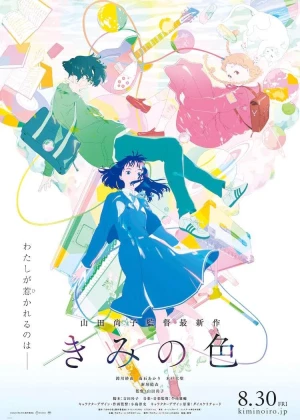The Colors Within
It's been a while since I last heard of Naoko Yamada, but that's probably because I tend to stay clear of contemporary anime series. Her last feature film dates from 2018 and left me a little wanting, but I was still excited to hear she had a new film out. And I must say, The Colors Within [Kimi no Iro] didn't disappoint in the slightest. It's a rather peculiar one, very lighthearted and dreamy, almost fleeting and devoid of any hard drama, but that's what makes it stand out. And with proper distribution already in place, there's no reason to skip this one.
![screencap of The Colors Within [Kimi no Iro]](/thumbs/img/articles/1200xauto/colors-within-1.webp)
Yamada is a veteran in the animation industry, rising to fame when she directed A Silent Voice in 2016. It's one of those landmark films often referenced when people are discussing the need for more female directors in animation. And rightfully so, Yamada has a particular feminine touch that helps set her films apart. It's not something that can be captured in a definite set of bullet points, but you can feel it while watching. You could argue a film like Only Yesterday is a close relative, but that would only further highlight the gap in approach of different genders.
The Colors Within is a film about a girl who has synesthesia (a condition that mixes sensations), but that's merely a visual motive slash plot device to make her a bit of an outcast. The film itself is more about the fears of growing up, about finding yourself and being yourself without disappointing the people around you. It's a coming-of-age story as there are many, but with a few original touches to set it apart from the rest. Most notably, there are few, if any, external sources of drama. It's mostly just the insecurities of the protagonists and how their time spent together helps them overcome personal hurdles.
Totsuko is a young girl who goes to a Christian boarding school. The rules are strict, but the teachers have the kids' interests at heart. Totsuko still feels like an outsider, as she has a rare condition called synesthesia, which mixes up sensory cues. It allows her to see colors in music and people, a condition she never shared with anyone before. When the girl she looks up to the most quits school, she makes it her mission to track her down. She finds her in a second-hand bookstore, where she also befriends a boy who likes to hang around in the store. The three of them decide to form a band.
![screencap of The Colors Within [Kimi no Iro]](/thumbs/img/articles/1200xauto/colors-within-2.webp)
The animation and art style are one of the main attractions of the film. The animation is very delicate and detailed, often focusing on smaller, gentler gestures that betray a character's emotions. This level of attention reminded me of Hayao Miyazaki's signature. Luckily, the art style ensures The Colors Within never feels like a mere Ghibli copycat. The character designs are distinctive and elaborate, the colors are airy and joyful, and a few well-timed style variations keep things interesting. This is a stunning-looking film crafted with attention and love for the medium, but it is very singular, and people who crave darkness might find it a bit too jolly.
Japanese pop music is a bit of an acquired taste, and few directors manage to integrate it well into their films, which is why I often avoid their band dramas. I wasn't the biggest fan of the music produced by our trio (though it wasn't the worst I've heard either), it's a good thing then that the rest of the score was on point. There are even some nifty surprises, like a rework of Underworld's Born Slippy, one of the last songs I expected to hear in this film. As for the dub, the voice acting fits in perfectly with the chirpy and breezy atmosphere. That is, if you stick with the Japanese voice cast, the American one is of the most grating I've heard in recent times (based on some quick sampling).
![screencap of The Colors Within [Kimi no Iro]](/thumbs/img/articles/1200xauto/colors-within-3.webp)
The Colors Within is not a very complex film, but the structure is somewhat unusual. You'd think the synesthesia or the band narrative would be driving forces in the plot, but that's not the case. They are but excuses to bring the leading trio together. The focus lies on the time they spend together and how these shared moments influence the relationships they have with themselves. The film touches on some deeper, important points, but it never does so in an overly heavy-handed or overbearing way, which is refreshing not just for an anime, but for any drama out there.
If this film proves anything, it's that Naoko Yamada is one of the better contemporary directors, having carved out a niche where she has little to no competition. The sumptuous visuals and gentle score are just vehicles that ease the audience into meeting three lovable characters who are slowly learning the ropes of life. If you like gentler and more toned-down anime, this is a rare gem that shouldn't be missed. I hope The Colors Within finds its audience, because the anime scene needs more stand-out feature films that aren't afraid to twist norms and expectations.
